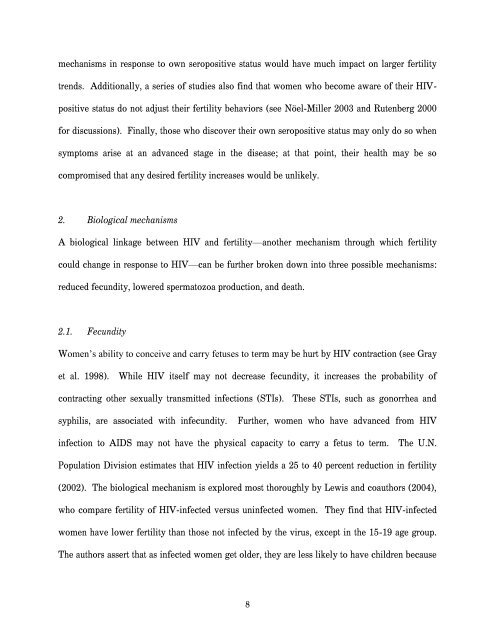A Closer Examination of the HIV/Fertility Linkage ... - Measure DHS
A Closer Examination of the HIV/Fertility Linkage ... - Measure DHS
A Closer Examination of the HIV/Fertility Linkage ... - Measure DHS
Create successful ePaper yourself
Turn your PDF publications into a flip-book with our unique Google optimized e-Paper software.
mechanisms in response to own seropositive status would have much impact on larger fertilitytrends. Additionally, a series <strong>of</strong> studies also find that women who become aware <strong>of</strong> <strong>the</strong>ir <strong>HIV</strong>positivestatus do not adjust <strong>the</strong>ir fertility behaviors (see Nöel-Miller 2003 and Rutenberg 2000for discussions). Finally, those who discover <strong>the</strong>ir own seropositive status may only do so whensymptoms arise at an advanced stage in <strong>the</strong> disease; at that point, <strong>the</strong>ir health may be socompromised that any desired fertility increases would be unlikely.2. Biological mechanismsA biological linkage between <strong>HIV</strong> and fertility—ano<strong>the</strong>r mechanism through which fertilitycould change in response to <strong>HIV</strong>—can be fur<strong>the</strong>r broken down into three possible mechanisms:reduced fecundity, lowered spermatozoa production, and death.2.1. FecundityWomen’s ability to conceive and carry fetuses to term may be hurt by <strong>HIV</strong> contraction (see Grayet al. 1998). While <strong>HIV</strong> itself may not decrease fecundity, it increases <strong>the</strong> probability <strong>of</strong>contracting o<strong>the</strong>r sexually transmitted infections (STIs). These STIs, such as gonorrhea andsyphilis, are associated with infecundity. Fur<strong>the</strong>r, women who have advanced from <strong>HIV</strong>infection to AIDS may not have <strong>the</strong> physical capacity to carry a fetus to term. The U.N.Population Division estimates that <strong>HIV</strong> infection yields a 25 to 40 percent reduction in fertility(2002). The biological mechanism is explored most thoroughly by Lewis and coauthors (2004),who compare fertility <strong>of</strong> <strong>HIV</strong>-infected versus uninfected women. They find that <strong>HIV</strong>-infectedwomen have lower fertility than those not infected by <strong>the</strong> virus, except in <strong>the</strong> 15-19 age group.The authors assert that as infected women get older, <strong>the</strong>y are less likely to have children because8








![Obtaining Informed Consent for HIV Testing [QRS4] - Measure DHS](https://img.yumpu.com/49850117/1/190x245/obtaining-informed-consent-for-hiv-testing-qrs4-measure-dhs.jpg?quality=85)







